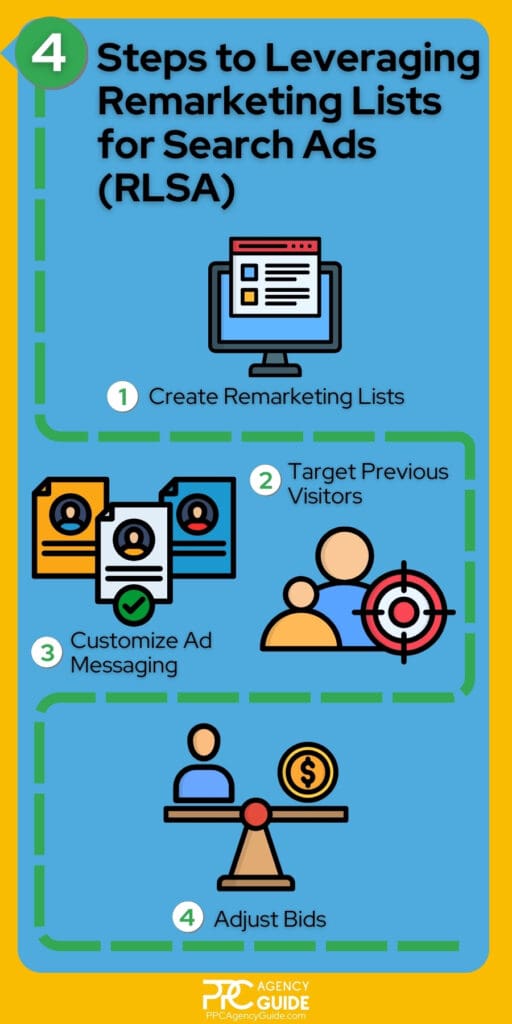
Have you ever noticed that most of your website visitors don’t stick around? You know you could turn many of them into loyal customers if only you had another chance to connect with them. Remarketing lists for search ads (RLSA) can make this happen. But what exactly are they, and how can they transform your digital marketing strategy? Get a complete walkthrough and Google RLSA tips below.
What is RLSA?
Remarketing lists for search ads is a feature within Google Ads that allows advertisers to tailor their search campaigns to target or exclude people who have previously visited their website while actively searching on Google.
How RLSA Works
Setting up and leveraging RLSA is a multi-step process. Let’s take a look at how it typically works below.

Create Remarketing Lists
To start using RLSA, you’ll need to create a remarketing list based on website visitors’ behavior. The lists can be segmented based on various criteria, such as specific pages visited, time spent on site, or completed actions like purchases or sign-ups.
Here, you should consider using remarketing lists to enhance your Google search ads, ensuring that your ads are displayed to people who have previously interacted with your site but did not convert. This is a critical step in setting up your remarketing.
Target Previous Visitors
Once the remarketing lists are set up, you can adjust your search campaigns to target these specific audiences when they perform relevant searches on Google. This allows you to develop more targeted and personalized messaging for users who have already shown interest in the business.
Consider using the Google Ads tag to tailor your search campaign or ad group more effectively. By targeting users with RLSA ads, you can reach out to those who have shown a strong interest in your products or services.
Customize Ad Messaging
You can adapt your messaging to resonate with previous visitors, offering promotions, discounts, or other incentives to encourage them to return to the site and complete a desired action.
Think about how you can use remarketing campaigns to deliver text ads or responsive search ads that are more appealing to your audience. Customize your ad copy to reflect the user’s previous behavior, making it more relevant and compelling.
Adjust Bids
With RLSA, you can adjust your bids for previous website visitors, bidding more aggressively for people who are more likely to convert based on their past behavior on the site. This helps you optimize ad spending and maximize ROI.
This is where strategic bid adjustments come into play. Use your Google Ads account to set up remarketing and adjust bids and ad positioning to ensure your ads appear in the search results at the most opportune times.
Benefits of RLSA
There are many benefits to leveraging RLSA. We’ll cover the basics below.
Boost ROI
RLSA allows you to target a highly relevant audience of previous website visitors who are more likely to convert. This results in a higher ROI than traditional search campaigns.
This targeting can be enhanced by using remarketing lists for search within your existing search or display remarketing campaigns, which can lead to more efficient use of your advertising budget and better ROI.
Increase Conversions
By targeting users who have already shown interest in the business, RLSA campaigns can drive higher conversion rates, ultimately leading to more sales or leads.
Enhance your strategy by tailoring your ads to these users, using audience lists and remarketing features to create a more compelling message that encourages them to act.
Enhance Personalization
RLSA enables you to deliver more personalized ad messaging to previous visitors, increasing the chances of engagement and conversion.
Make use of the ability to add a remarketing list to your campaign or ad group to further personalize the experience. Tailor your search ads to show users the products or services they viewed but didn’t purchase, using responsive ads to dynamically adjust the content.
Boost Ad Performance
Due to the ability to adjust bids based on past user behavior, RLSA campaigns often yield better ad performance and cost-efficiency than generic search campaigns.
Consider how using RLSA strategies can lead to better ad performance across the Google Search Network and Google Display Network. This focused approach helps ensure that your ads are seen by users who are already familiar with your brand, enhancing the likelihood of engagement.
How to Build Effective Remarketing Lists
Building effective remarketing lists is crucial for the success of RLSA campaigns. Here’s a step-by-step guide on how to build them effectively.
Identify Key Segments
Start by identifying the key segments of your website visitors that you want to target with your RLSA campaigns. This may include visitors who abandoned their shopping carts, those who visited specific product pages, or even users who spent a certain amount of time on your site.
Set Up Google Analytics
If you haven’t already, set up Google Analytics on your website. Google Analytics provides valuable insights into user behavior, which can help you identify the most valuable segments for your remarketing lists.
Create Remarketing Audiences
To create an audience in Google Analytics (GA4), navigate to the “Tools & Settings” section and then to the “Audience Manager” and “Audience Lists.” Next, choose “Create Audience” and “Website traffic” as the source. From there, you can select your GA4 property and identify the audience criteria you want to use, such as page views, session duration, or completed goals.
Install Remarketing Tags
Once you’ve created your remarketing audiences in Google Analytics, you must install the Google Ads remarketing tag on your website. This tag allows Google Ads to track visitors and add them to your remarketing lists based on your defined criteria.
Set Membership Duration
Determine how long visitors should remain on your remarketing lists. This duration can vary depending on your business goals and your customers’ typical buying cycles. For example, if you have a short sales cycle, you may want to set a shorter membership duration to target recent visitors.
Test and Refine
Continuously monitor the performance of your remarketing lists and adjust them as needed. Test different audience segments, membership durations, and messaging to identify what works best for your business.
Combine with Customer Data
Consider integrating your remarketing lists with customer data from other sources, such as your customer relationship management (CRM) system or email marketing platform. This can help you create even more targeted and personalized remarketing campaigns.
Strategies for Targeting with RLSA
When it comes to targeting with RLSA, several strategies can be implemented to maximize the effectiveness of their campaigns.
Customize Ad Copy for Returning Visitors
One effective strategy is to customize ad copy specifically for returning visitors. Since these users have already interacted with your website, they are likely further along in the customer journey and may respond better to messaging that acknowledges their previous interaction. For example, you can adapt your ad copy to highlight new products or promotions, remind them of items they viewed but didn’t purchase, or offer exclusive discounts for returning visitors.
Incorporate this strategy by using RLSA tactics to serve them ads that resonate with their previous interactions. Tailor your search ads to engage these users effectively, reminding them of the unique benefits of your offerings.
Adjust Bids Based on User Behavior
Bid adjustments are a crucial aspect of RLSA campaigns. By analyzing past user behavior and adjusting bids accordingly, advertisers can ensure they are bidding more aggressively for users who are more likely to convert. For example, you may want to increase bids for people who abandoned their shopping carts or visited high-value pages on your website, as they are more likely to convert than users visiting for the first time.
Optimize Ad Position and Budget Allocation
In addition to bid adjustments, optimizing ad position and budget allocation for RLSA campaigns is essential. Focus your budget on targeting high-intent audiences who are more likely to convert and prioritize bidding for top ad positions to increase visibility and drive more clicks from returning visitors.
Segment and Exclude
Take advantage of segmentation and audience exclusion features to refine your targeting strategy. Segment your remarketing lists based on different criteria, such as demographics, geographic location, or device usage, and adjust your bidding and messaging accordingly. Additionally, consider excluding certain audiences from your RLSA campaigns to avoid targeting users who may not be relevant or who have already converted.
Improving Your Campaigns with RLSA Tactics and Google Ads Remarketing
Incorporating advanced RLSA tactics into your Google Search Ads remarketing efforts can significantly enhance your Google search. By tailoring your ads to people who have previously interacted with your website, you can ensure that your messages reach the most interested audiences. Utilize the Google Ads tag to add a remarketing list to your campaign or ad group, making your ads more relevant and increasing the likelihood of conversion. Whether you’re setting up your remarketing or optimizing existing search campaigns, using RLSA allows you to serve tailored ads to people performing relevant searches. This approach gets your ads to appear at the top of the search results page, capturing attention and driving re-engagement.
Advanced Tactics for RLSA Campaigns

Now that we’ve covered the basics, let’s explore some advanced tactics to maximize the effectiveness of RLSA campaigns. Explore more advanced strategies and get deeper insights into optimizing your RLSA campaigns for maximum ROI.
Dynamic Remarketing
Dynamic remarketing kicks RLSA up a notch by dynamically generating ads based on the specific products or pages that users viewed on your website. By using dynamic remarketing, you can create highly personalized ads that showcase the exact products or services that users showed interest in, increasing the likelihood of conversion.
Cross-Selling and Upselling
RLSA campaigns provide an excellent opportunity to cross-sell or upsell to existing customers or previous website visitors. For example, if a user previously purchased a product from your website, you can target them with ads promoting complementary products or upgrades. This can help increase the average order value and maximize your customers’ lifetime value.
Sequential Remarketing
Sequential remarketing involves showing users a specific sequence of ads based on their past interactions with your website. For example, you can create a sequence of ads that starts with a general brand awareness message, followed by more targeted ads promoting specific products or offers. This sequential approach helps guide users through the sales funnel and encourages them to take the desired action.
Custom Combination Lists
Google Ads allows advertisers to create custom combination lists by combining multiple remarketing lists with logical operators (AND, OR, NOT). This enables you to create highly targeted audience segments based on specific criteria. For example, you can create a custom combination list that targets users who visited your website in the past 30 days, viewed a specific product page, and did not complete a purchase. Custom combination lists allow for precise targeting and messaging, increasing the chances of conversion.
Get Help Implementing Remarketing Lists for Search Ads
RLSA can help you dramatically improve your PPC results, but it is an advanced technique that requires skills and time many in-house teams don’t possess. If you’d like to explore what RLSA can do for your campaigns, request a complimentary consultation.
Frequently Asked Questions, Answered
How can I grow my business with search ads?
Most people think of Google Ads when the conversation is about search ads. There are many other search ad platforms that one can use to increase the effectiveness of your search ad campaign. Research your target audience and identify the platforms that they frequent, and target them with ads on those platforms.
What are the search ads essentials?
- Doing search ads well means making sure that you first determine if search ads are right for your type of business. This will prevent you from wasting money and getting a poor return on your ad spend.
- Using search ads is instant when compared to SEO. The moment your campaign is set up, they start to show on the search engine results.
- Search ads give you lots of control. You can choose your search ads to run at specific times and dates, thus giving you control to target at just the right time.


















